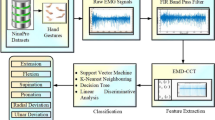Abstract
One of the main disturbances in EEG signals is EMG artefacts generated by muscle movements. In the paper, the use of a linear phase FIR digital low-pass filter with finite wordlength precision coefficients is proposed, designed using the compensation procedure, to minimise EMG artefacts in contaminated EEG signals. To make the filtering more effective, different structures are used, i.e. cascading, twicing and sharpening (apart from simple low-pass filtering) of the designed FIR filter. Modifications are proposed to twicing and sharpening structures to regain the linear phase characteristics that are lost in conventional twicing and sharpening operations. The efficacy of all these transformed filters in minimising EMG artefacts is studied, using SNR improvements as a performance measure for simulated signals. Time plots of the signals are also compared. Studies show that the modified sharpening structure is superior in performance to all other proposed methods. These algorithms have also been applied to real or recorded EMG-contaminated EEG signal. Comparison of time plots, and also the output SNR, show that the proposed modified sharpened structure works better in minimising EMG artefacts compared with other methods considered.
Similar content being viewed by others
References
Barlow, J. S. (1979): ‘Computerized electroencephalography in perspective’,IEEE Trans.,BME-26, pp. 377–391.
Barlow, J. S. (1983): ‘Muscle spike artefact minimisation in EEG by time domain filtering’,Electroenceph. Clin. Neurophysiol.,55, pp. 487–491.
Barlow, J. S. (1984): ‘EMG artefact minimisation during clinical recording by special analog filters’,Electroenceph. Clin. Neurophysiol.,58, pp. 161–174.
Chan, D. S. K. andRabiner, L. R. (1973): ‘Analysis of quantisation errors in the direct form for finite impulse response digital filters’,IEEE Trans.,AE-21, pp. 354–366.
Gevins, A. S., Yeager, C., Diamond, S., Spire, J., Zeitlin, G., andGevins, A. H. (1975): ‘Automated analysis of the electrical activity of the human brain (EEG): a progress report’,Proc. IEEE,63, pp. 1382–1399.
Gotman, J., Ives, J. R., andGloor, P. (1981): ‘Frequency content of EEG and EMG at seizure onset: possibility of removal of EMG artefact by digital filtering’,Electroenceph. Clin. Neurophysiol.,52, pp. 626–639.
Johnson, T. L., Feidman, R., andSax, D. (1973): ‘Reduction of muscle artefact in electroencephalographic recordings’,Am. J. Electroenceph. Technol.,13, pp. 13–25.
Johnson, T. L., Wright, S. C., andSegall, A. (1979): ‘Filtering of muscle artefact from the electroencephalogram’,IEEE Trans.,BME-26, pp. 556–563.
Kaiser, J. F., andHamming, R. W. (1977): ‘Sharpening the response of a symmetrical nonrecursive filter by multiple use of the same filter’,IEEE Trans.,ASSP-25, pp. 415–422.
Kodek, D. M. (1980): ‘Design of optimal finite wordlength FIR digital filters using integer programming technique’,ibid.,,ASSP-28, pp. 304–308.
McClellan, J. H., Parks, T. W., andRabiner, L. R. (1973): ‘A computer program for designing optimum FIR linear phase digital filters’,IEEE Trans.,AE-21, pp. 506–526.
Narasimhan, S. V. andNarayana Dutt, D. (1985): ‘Software simulation of the EEG’,J. Biomed. Eng.,7, pp. 275–281.
O'Donnel, R. D., Berkhout, J., andRoss Adey, W. (1974): ‘Contamination of scalp EEG spectrum during contraction of craniofacial muscles’,Electroenceph. Clin. Neurophysiol.,37, pp. 145–151.
Panych, L. P., Wada, J. A., andBeddoes, M. P. (1989): ‘Practical digital filters for reducing EMG artefacts in EEG seizure recordings’,ibid.,,72, pp. 268–276.
Tukey, J. W. (1977): ‘Exploratory data analysis’ (Addison-Wesley, Reading, Massachusetts).
Author information
Authors and Affiliations
Rights and permissions
About this article
Cite this article
Sadasivan, P.K., Dutt, D.N. Use of finite wordlength FIR digital filter structures with improved magnitude and phase characteristics for reduction of muscle noise in EEG signals. Med. Biol. Eng. Comput. 33, 306–312 (1995). https://doi.org/10.1007/BF02510504
Received:
Accepted:
Issue Date:
DOI: https://doi.org/10.1007/BF02510504




